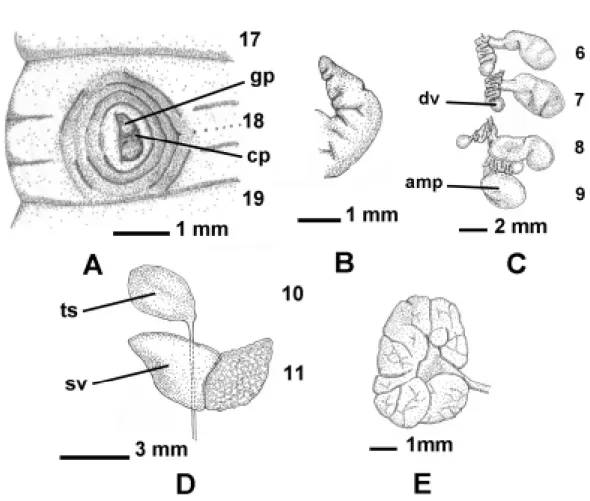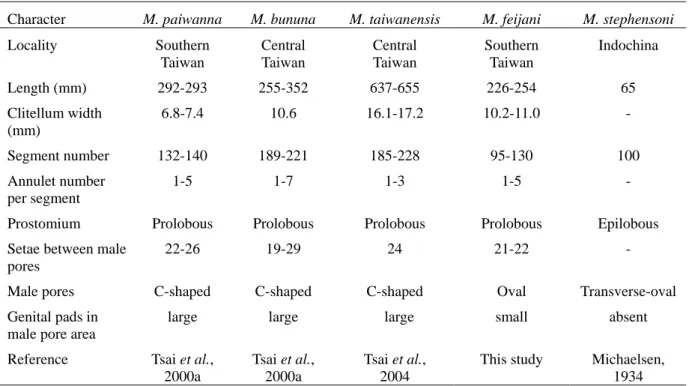A New Species of Earthworm Belonging to the Genus Metaphire
Sims and Easton 1972 (Oligochaeta: Megascolecidae) from
Southern Taiwan
Chih-Han Chang(1) and Jiun-Hong Chen(1,2,3)
(Manuscript received 27 September, 2004; accepted 4 November, 2004)
ABSTRACT: This paper described a new species of earthworm from southern Taiwan Metaphire feijani. This species belongs to the octothecate stephensoni-species group within the genus Metaphire.
The morphological comparison of species within this group revealed the identity of this new species.
KEY WORDS: Earthworms, New species, Metaphire feijani, Taiwan.
INTRODUCTION
Most earthworm species in Taiwan belong to the genus Amynthas or Metaphire in the family Megascolecidae. Within the 23 new species described from Taiwan between 1999 and 2004 (Shen and Tsai, 2002; Shen et al., 2002, 2003; Tsai et al., 1999, 2000a, b, 2001, 2002, 2003, 2004), Pithemera lanyuensis (Shen and Tsai, 2002) is the only species which was not belong to the two genera. On the other hand, most of the recently described species were collected from central Taiwan. Metaphire paiwanna and M. yeni are the only two new species which were found from southern Taiwan recently (Tsai et al., 2000a, b). Due to limited survey in southern Taiwan, these results might evoke a bias image which shows the species richness of earthworm in southern Taiwan is lower than that in central Taiwan. This paper described a new species from southern Taiwan. This species belongs to the stephensoni-species group within Metaphire. The differences among all taxa within this group are also compared.
MATERIALS AND METHODS
Earthworm samples collected from the mountain areas in southern Taiwan were anaesthetized in 10% ethanol solution, fixed in 5% formalin solution, and preserved in 70% ethanol solution. The type specimens and other materials examined are deposited at Institute of Zoology, National Taiwan University, Taipei, Taiwan.
TREATMENT
Metaphire feijani C.-H. Chang and J.-H. Chen, sp. nov. 飛棧腔環蚓 Fig. 1
Holotype: a mature (clitellate) specimen (dissected) collected 10 February 2004 from ___________________________________________________________________________
1. Institute of Zoology, National Taiwan University, No.1, Sec. 4, Roosevelt Road, Taipei 106, Taiwan. 2. Department of Life Science, National Taiwan University, No.1, Sec. 4, Roosevelt Road, Taipei 106, Taiwan. 3. Corresponding author. Tel: 886-2-23630231 ext. 2354; Fax: 886-2-23658912; Email: chenjh@ntu.edu.tw
Fig. 1. Metaphire feijani. A: Right male pore, ventral view (gp, genital pad; cp, copulatory pouch). B: Right caecum, dorsal view. C: Right spermathecae, dorsal view (dv, diverticulum; amp, ampulla). D: Left testis sac and seminal vesicle, dorsal view (ts, testis sac; sv, seminal vesicle). E: Left prostate gland, dorsal view.
Majia, Pingtung County in southern Taiwan (22°41´N, 120°41´E) by C.-H. Chang (Cat. No. 14-07095).
Paratype: a mature (clitellate) specimen (dissected) collected 10 February 2004 from Wutai, Pingtung County in southern Taiwan (22°45´N, 120°43´E) by C.-H. Chang (Cat. No. 14-07099).
Other materials
Two immature specimens collected 10 February 2004 from Majia, Pingtung County (22°41´N, 120°41´E) by C.-H. Chang (Cat. No. 14-07096, 14-07097); and an immature specimen collected 10 February 2004 from Wutai, Pingtung County (22°45´N, 120°43´E) by C.-H. Chang (Cat. No. 14-07098).
External characters
Length (mature) 226-254 mm, clitellum width 8.0-10.7 mm, segment number 95-130. Number of annulets (secondary segmentation) per segment three in 6-9, five in 10-13, and three in body segments behind 17. Prostomium prolobous. Setae 76-92 in 7, 101-104 in 20, 21-22 between male pores. First dorsal pore in 12/13. Clitellum 14-16, smooth, length 10.2-11.0 mm, dorsal pore absent, setae absent. Spermathecal pores four pairs in 5/6-8/9, invisible from outside, ventral, distance between the paired pores about 0.27-0.35 body
circumference ventrally apart. No genital papillae in the spermathecal pore region. Female pore single, situated on the medio-ventral in 14. Male pores (opening of copulatory pouch) small, paired, situated on setal line close to lateral border of 18. Each copulatory pouch is compressed to the outer body wall, surrounded by 2-6 circular folds, laterally bordered by a thick skin lip. The opening of copulatory pouch is a split parallel to the body axis, facing the medio-ventral line. Male aperture is embedded in the copulatory pouch and is inconspicuous. A small genital pad resides in the front of the opening of the copulatory pouch. Genital papillae absent in the male pore area.
Live specimens bluish brown with metallic luster on dorsum, light reddish brown on ventral. Preserved specimens purplish brown on dorsum, light brown on ventral.
Internal characters
Septa 5/6-7/8 thickened, 8/9 thin, 9/10 absent, 10/11-13/14 greatly thickened. Gizzard in 8-10. Intestine enlarged from 15. Intestinal caeca paired in 27, simple, extending anteriorly to 26. Lateral hearts enlarged in 10-13.
Spermathecae four pairs in 6-9. Ampulla large, about 2.8-4.2 mm in length, with a stalk about 1.4-2.4 mm in length. The spermathecal diverticulum short, around the middle of spermathecae, with a small oval seminal chamber on the tip. diverticulum stalk long, tightly coiled, forming a short and thick appearance. Nephridia tufted, attached to the post-segmental septa, surrounding the segmental chambers anterior to the 6/7 septum. Ovaries paired in 13, medio-ventral, close to the 12/13 septum.
Testis sacs paired in 10, oval-shaped, smooth, medio-ventral in front of 10/11. Seminal vesicles paired in 11, large, each one with a folliculate dorsal lobe. Prostate glands paired in 18, large, lobular, extending to 17 and 19.
Localities and Habitats
This species lives in the mountain areas around the altitude of 600 meters, where the main vegetation is broadleaf forest, either virgin forest or secondary forest. This species is an anecic species, having permanent vertical burrows. The collection site in Majia is a shallow ditch by the road, near the entrance of Majia Village. The circumstance nearby the ditch is secondary forest. The ditch is about 10 cm in depth, covered with soil mixed with gravel. The collection site in Wutai is also a ditch by the road, near Shenshan, but the nearby circumstance is virgin forest mixed with small patches of secondary forest. The ditch is about 40 cm in depth. Soil presents only near the edge of the ditch bottom.
Remarks
Metaphire feijani is octothecate and protandric (with one pair of testes in 10), and therefore belongs to the stephensoni-species group (Sims and Easton, 1972; Tsai et al., 2004) within Metaphire. This species group includes other four species (Tsai et al., 2004). They are M. paiwanna, M. bununa, and M. taiwanensis of Taiwan and M. stephensoni of southern Indochina. Regarding Taiwanese species, the spermathecal diverticulum stalks of M. paiwanna, M. bununa, and M. taiwanensis are not tightly coiled; the male pores of the latter three species are C-shaped, and a large genital pad instead of a small one presents in the male pore area of these three species (Tsai et al., 2000a, 2004). Besides, M. taiwanensis is a gigantic earthworm, with length longer than 50 cm, and distributes in central Taiwan (Tsai et al., 2004). Generally, it is easy to distinguish M. feijani from the other three species by morphology. So far, only five specimens of M. feijani were found from two separated sites.
Due to M. paiwanna is abundant in the neighbouring regions including these two described sites and M. feijani is restricted in the two small areas only, the habitats of these two species seem ecologically different. Regarding M. stephensoni, it has smaller body size than M. feijani and has transverse-oval male pores (Michaelsen, 1934) with genital papillae. Hence, these two species are remarkably different. The comparison of stephensoni-species group is listed in Table 1.
The species epithet ‘feijani’ is given in memory of the Taiwanese evolutionary biologist Dr. Fei-Jan Lin, who made a significant contribution during the early study period of Taiwanese earthworms.
Table 1. The comparison of stephensoni-species group of the genus Metaphire.
ACKNOWLEDGEMENTS
We are grateful to Y.-H. Chen, Y.-S. Lin, and J.-H. Wu, who helped in the field survey in southern Taiwan. This study was supported by the National Science Council of R.O.C. (NSC 92-2621-B-002-019) to J.-H. Chen.
LITERATURE CITED
Michaelsen, W. 1934. Oligochaten von Franzosisch-Indochina. Arch. Zool. Exp. Gen. 76: 493-546.
Shen, H.-P. and C.-F. Tsai. 2002. A new earthworm of the genus Pithemera (Oligochaeta: Megascolecidae) from Lanyu Island (Botel Tabago). J. Natl. Taiwan Mus. 55: 1-7.
Shen, H.-P., C.-F. Tsai and S.-C. Tsai. 2002. Description of a new earthworm belonging to
Character M. paiwanna M. bununa M. taiwanensis M. feijani M. stephensoni
Locality Southern Taiwan Central Taiwan Central Taiwan Southern Taiwan Indochina Length (mm) 292-293 255-352 637-655 226-254 65 Clitellum width (mm) 6.8-7.4 10.6 16.1-17.2 10.2-11.0 - Segment number 132-140 189-221 185-228 95-130 100 Annulet number per segment 1-5 1-7 1-3 1-5 -
Prostomium Prolobous Prolobous Prolobous Prolobous Epilobous Setae between male
pores
22-26 19-29 24 21-22 -
Male pores C-shaped C-shaped C-shaped Oval Transverse-oval Genital pads in
male pore area
large large large small absent
Reference Tsai et al.,
2000a
Tsai et al., 2000a
Tsai et al., 2004
This study Michaelsen, 1934
the genus Amynthas (Oligochaeta: Megascolecidae) from Taiwan and its infraspecific variation in relation to elevation. Raffles Bull. Zool. 50: 1-8.
Shen, H.-P., C.-F. Tsai and S.-C. Tsai. 2003. Six new earthworms of the genus Amynthas (Oligochaeta: Megascolecidae) from Central Taiwan. Zool. Stud. 42: 479-490.
Sims, R. W. and E. G. Easton. 1972. A numerical revision of the earthworm genus Pheretima auct. (Megascolecidae: Oligochaeta) with the recognition of new genera and an appendix on the earthworms collected by the Royal Society North Borneo Expedition. Biol. J. Linnean Soc. 4: 169-268.
Tsai, C.-F., H.-P. Shen and S.-C. Tsai. 1999. On some new species of the pheretimoid earthworms (Oligochaeta: Megascolecidae) from Taiwan. J. Natl. Taiwan Mus. 52: 33-46.
Tsai, C.-F., S.-C. Tsai and G.-J. Liaw. 2000a. Two new species of protandric pheretimoid earthworms belonging to the genus Metaphire (Megascolecidae: Oligochaeta) from Taiwan. J. Nat. Hist. 34: 1731-1741.
Tsai, S.-C., H.-P. Shen and C.-F. Tsai. 2000b. A new pheretimoid earthworm with latero-dorsal genital papillae. J. Natl. Taiwan Mus. 53: 7-14.
Tsai, C.-F., H.-P. Shen and S.-C. Tsai. 2001. Some new earthworms of the genus Amynthas (Oligochaeta: Megascolecidae) from Mt. Hohuan of Taiwan. Zool. Stud. 40: 276-288. Tsai, C.-F., H.-P. Shen and S.-C. Tsai. 2002. A new athecate earthworm of the genus
Amynthas Kinberg (Megascolecidae: Oligochaeta) from Taiwan with discussion on phylogeny and biogeography of the A. illotus species group. J. Nat. Hist. 36: 757-765. Tsai, C.-F., J.-H. Chen, S.-C. Tsai and H.-P. Shen. 2003. A new species of the earthworm
belonging to the genus Metaphire Sims and Easton (Megascolecidae: Oligochaeta) from the northeastern Taiwan. Endemic Species Res. 5: 83-88.
Tsai, C.-F., S.-C. Tsai and H.-P. Shen. 2004. A new gigantic earthworm of the genus Metaphire Sims and Easton (Megascolecidae: Oligochaeta) from Taiwan with reference to evolutional trends in body sizes and segment numbers of the Pheretima genus-group. J. Nat. Hist. 38: 877-887.

